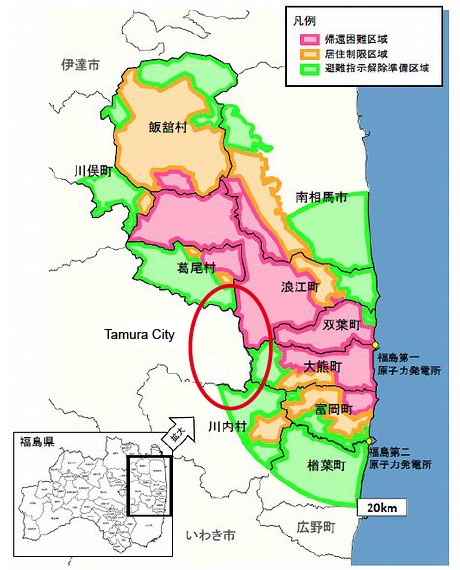Tamura City will be the first place in Fukushima to have its evacuation order lifted, in what prime minister Shinzo Abe hopes will be a period of visible recovery. Industry welcomed the development, three years after the earthquake, tsunami and nuclear accident.
About 3200 residents from the district of Miyakoji on the eastern edge of Tamura evacuated on 12 March 2011, as the crisis at Fukushima Daiichi worsened. Extensive clean-up enabled residents limited access from mid-2013 and the repair of infrastructure means they will be allowed to return and resume their lives freely from 1 April. Farmers' crops of rice are already growing, local shops will be open and returning people will be offered specialist advice and analysis of their personal radiation exposure.
 |
| Green areas are categorised as 'ready to return' and the eastern part of Tamura City (circled) has become the first to change from green to unrestricted white |
Announcing the decision yesterday, Abe said, "Our efforts will not be over until the people who have returned get rid of their concerns regarding their health, their jobs and so on one by one and restore their daily lives in which they can enjoy peace of mind."
Cleaning up
World Nuclear Association director general Agneta Rising welcomed the lifting of the evacuation order. "The evacuation following the Fukushima accident has caused great disruption to many people's lives. But good progress has been made at the Fukushima site over the last three years. Although there is still much to address, the situation is stable. Many of those places evacuated near Fukushima are now within normal levels of background radiation for most of the world; these are levels that people live with and we don't see any health impact. It is safe for people to return and we hope to see many more return soon."
Decontamination of living areas, farmland, forest and roads in Tamura City was declared to be 100% complete in June 2013. Over a period of just under a year, workers spent a total of 120,000 man days decontaminating nearly 230,000 square metres of building surfaces as well as 96 kilometres of roads, 1.2 million square metres of farmland and nearly 2 million square metres of forests using a variety of techniques including pressure washing and topsoil removal.
Abe admitted that reconstruction after the earthquake, tsunami and nuclear accident had been "extensively delayed" but said real progress had been made in the last 12 months, albeit often out of the public eye. In the coming year, he said, that progress should be visible and tangible to the Japanese people. He noted that a 30 kilometre stretch of the Joban Expressway connecting Tokyo to Sendai is out of commission and awaiting earthquake repairs. Its route through contaminated areas of Fukushima prefecture has prevented this, but Abe hopes for the road to re-open in mid 2015.
Researched and written
by World Nuclear News





_63865.jpg)
_18570.jpg)
_16159.jpg)





